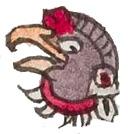cozcacuauhtli (Mdz13r)
This element for vulture (cozcacuauhtli) has been carved from the compound sign for the place name, Cozcacuauhtenanco. Only the vulture's head is visible. It is shown in profile, looking to our left. Its beak is slightly open. Its head is largely purple, but there is a red element above the eyes. The beak is a terracotta color. It has a red band around its neck, with what appear to be small white feathers sticking out below the red ring. It appears to have an ear or an earring.
Stephanie Wood
The red band with feathers at the base of the bird's head has the look of a necklace (cozcatl), which could be a phonetic indicator for a reading of cozcacuauhtli over, say, simply cuauhtli (eagle). The cozcacuauhtli was a calendrical symbol, and probably therefore, also taken as a personal name.
Stephanie Wood
c. 1541, but by 1553 at the latest
Stephanie Wood
feathers, plumas

cozcacuauh(tli), vulture or redheaded eagle, https://nahuatl.wired-humanities.org/content/cozcacuauhtli-0
cozca(tl), necklace, https://nahuatl.wired-humanities.org/content/cozcatl-0
cuauh(tli), eagle, https://nahuatl.wired-humanities.org/content/cuauhtli
el buitre
Stephanie Wood
Codex Mendoza, folio 13 recto, https://digital.bodleian.ox.ac.uk/objects/2fea788e-2aa2-4f08-b6d9-648c00..., image 36 of 188.
The Bodleian Libraries, University of Oxford, hold the original manuscript, the MS. Arch. Selden. A. 1. This image is published here under the UK Creative Commons, “Attribution-NonCommercial-ShareAlike 3.0 License” (CC-BY-NC-SA 3.0).



